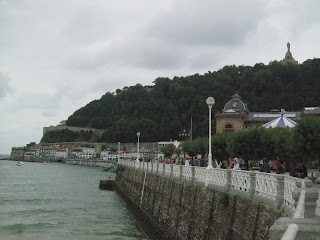After a few hours of sleep on Friday night, I said goodbye to Madrid for good and left on a 5-hour train ride to San Sebastián to start my adventures.
And it's a good thing I did, because when I said Granada was my favorite city in Spain, I was lying. San Sebastián is my favorite city in Spain.
train
The second-class tickets for this particular train were sold out, but the first-class tickets only cost me 10 euros with a Eurail pass. The only difference as far as I could tell between first and second class on RENFE was that I got served the most delicious breakfast ever.
Croissant, piece of bread, Greek yogurt, Spanish omlette, fried eggplant in tomato sauce, small white chorizo, tea, orange juice. And with the bread they gave us butter and jam and an adorable tiny 2-oz bottle of olive oil.
hostel
Because I am staying in San Sebastian for two nights, I booked two nights in a hostel - The Hostel Lagunak, right in the of the Parte Vieja in San Sebastian. It is a very pleasant hostel with friendly staff, clean linens, full kitchen, and washer/dryer. The staff is friendly and nice, and the hostel couldn't be better situated in the old town. When I had a problem with one of the guests at the hostel who was super drunk, they helped me out and let me change rooms. This place definitely gets a good review in my book.
history/geography
San Sebastián is the name in castellano Spanish for a city that the Basque people call Donostia. It was originally a huge whaling port, with the Basque sailors sometimes going on month-long whaling missions. Some historians suspect that the Basque people even found the Americas before Christopher Columbus, and many more think that Christopher Columbus's ships were Basque-built. Not a lot is known about the origin of the Basque people, since their language (Euskara) is completely unrelated to any other language in the world.
San Sebastián is in the north of Spain on the Cantabrian sea:
And as a result, it has a bit of everything. Hiking, climbing, beach, surf, jobs, happy people, amazing food.
While the majority of the population speaks in Basque (and the directional signs are all in Basque), it is still Spain (some Basque people might disagree with you on that point), and therefore everyone speaks traditional Spanish (castellano).
the day
We (Erica, Josh, Sophie, and I) were really lucky that Ekavali was in town this weekend. Erica, Sophie, and Josh got crash space, and we all got an amazing tour of the city!
The first thing we did (after finding a quick nom of course) was hike up to see Jesus. Oh yea, the city of San Sebastián has a huge Jesus statue that overlooks the entire city.
But when you hike up the 20 minutes or so to the top, he just kind of stares you down.
I'm not quite sure of the history of the Jesus statue - most of the signs and descriptions on the mountain were in Euskara, so I wasn't very motivated to decipher them.
On the way up we found an interesting English cemetery (from the "Carlist wars" - yet another piece of history I need to look up).
After finishing up with Jesus, we hiked back down and walked across the beach, eventually getting to these cool iron sculptures at the opposite end of the beach. While walking across the beach Erica decided it would be cool to prance....
And the cool iron sculptures were placed among rocks and things we could climb around. The people standing on the beach thought we were crazy by climbing around on the rocks, but it was perfectly safe.
the evening
Once it got dark, we were ready for a tour of the "food capital of Spain." Thank goodness Ekavali was with us, because she knew exactly where to take us!
We had delicious tapas - oxtail, bacalao (fish), squid, mejillones (mussels), and many many more! Although the portions were small (they come in the pinchos variety), it was very very filling.
In the Basque Country, the portions of food that are standard are pinchos (spelled pintxos). It is in fact the same word, since the tx in Basque makes the "ch" sound. What this means is a piece of bread with a small item of food, usually ordered with a drink and to share among many people.
After having the pinchos here in San Sebastián I think most of the pinchos I've had in Madrid were put to shame.
San Sebastián part 2 coming soon....









































